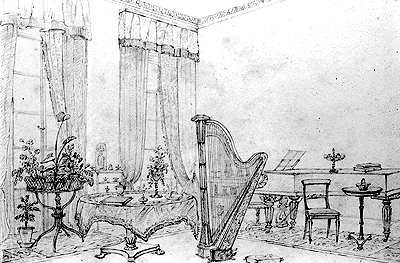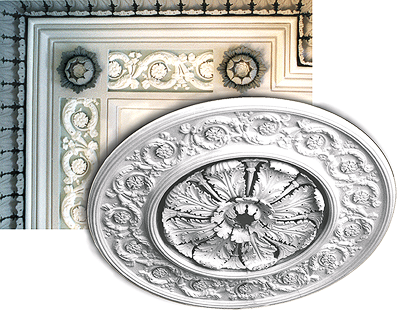In contrast to the dining room and parlour, the two drawing rooms on the first floor were lighter and more feminine in decoration and linked by folding doors. This was where the family relaxed, where the lady of the house received morning calls and where people retired after the evening meal. Elegant soft furnishings, exquisitely carved furniture and expensive musical instruments, all set upon Brussels weave carpets and against a backdrop of wallpaper, rich curtains and drapes, gave a feeling of great luxury, enhanced at night by the glittering light cast from ornate chandeliers.

Above: Sketch of a drawing room in a Regency home.
Decorative features being restored at the Town House include the white marble drawing room fireplaces, the plaster cornices and the intricate ceiling roses. Whilst to modern eyes the decoration in these rooms and those on the ground floor is elaborate, it is far more restrained than earlier in the Georgian period. The simpler style was now considered an elegant and appropriate setting for rich furnishings.
rooms and those on the ground floor is elaborate, it is far more restrained than earlier in the Georgian period. The simpler style was now considered an elegant and appropriate setting for rich furnishings.
Drawing room design and decoration reflected an important Regency preoccupation - the harmony of man and nature. Large floor to ceiling windows show the desire to link the house to the gardens and nature beyond. At the Town House, views of the sea, the Downs and the Square were reflected around the room by two large gilt mirrors, one above the fireplace, the other facing it on the opposite wall.
This fascination with trickery and artifice was evident throughout the house. For instance, pine was cheap, plentiful and so was commonly used to make fixtures such as doors, window frames and skirting boards, but Regency decorators disguised it by applying a 'grained' paint effect so that it acquired the appearance of more exotic and expensive woods, like oak and satin wood.